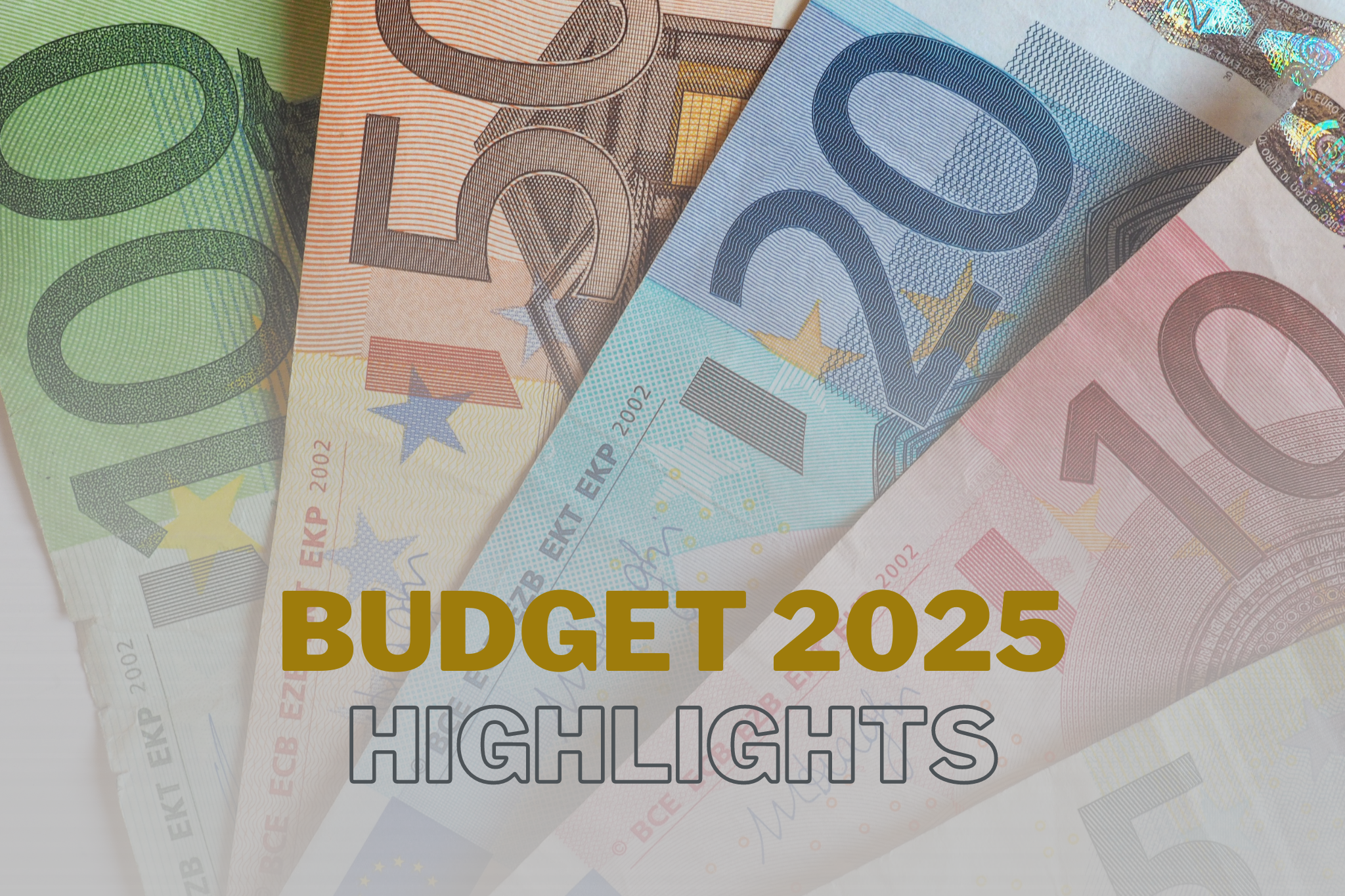
Minister for Finance, Jack Chambers delivered the final Budget today, 1 October 2023. Below we outline the highlights of Budget 2025.
Personal Tax
- Income Tax Standard Rate Bands increase by €2,000 to €44,000 (single person), with the married single earner band increasing to €53,000, and the married dual income band increasing to €88,000.
- Personal, PAYE, Earned Tax Credits to increase by €125 to €2,000.
- Home Carer and Single Person Child Carer Tax Credits will increase by €150 to €1,950 and €1,900 respectively.
- Incapacitated Child and Blind Person’s Tax Credits will increase by €300 to €3,800 and €1,950 respectively.
- Small change to the second rate-band of Universal Social Charge which will increase from €25,760 to €27,382. The 4% rate is reducing to 3% from 1 January 2025.
- Alignment to the tax treatment of Automatic Enrolment Retirement Savings Schemes so that they are similar to that of PRSAs. Employer contributions are tax relieved. Funds grow tax free and a tax-free lump sum can be taken on draw down of the fund up to a maximum of €200,000.
Enterprise/SMEs
- Ireland is the only country in the EU which taxes dividends from foreign subsidiaries. It is proposed to introduce a participation exemption for Foreign Dividends to simplify the double taxation relief provisions. Companies will have an option to claim the exemption or continue to use the existing tax and credit relief by way of an election on the company’s annual Corporation Tax return. The exemption will apply for distributions received on or after the 1 January 2025.
- Capital Gains Tax Relief for Angel Investment to encourage investment in innovative start-ups is to commence shortly. Qualifying investments will be certified by Enterprise Ireland with a minimum investment in new shares of at least €10,000. Relief will apply if shares are held for at least 3 years. A reduced rate of Capital Gains Tax of 16% will apply on a gain of up to twice the initial investment. A lifetime limit of €10m will apply to the relief.
- A 12-year clawback period for Retirement Relief on disposals to children on businesses valued at over €10m.
- The various reliefs for Investment in Corporate Trades are being extended for a further two years to 31 December 2025. The €500,000 investor limit on EII investment is being increased to €1m, while it is being increased to €980,000 for SURE investments.
- The first-year payment threshold for the Research & Development Tax Credit is being increased to €75,000. The first-year payment threshold, which allows for a claim to be repaid in full rather than spread over 3 years.
- The Section 486C Start Up Relief is currently calculated by reference to the amount of employer PRSI paid – up to €5,000 per employee. It is proposed that amounts paid under Class S will also be considered, subject to a maximum of €1,000 per individual.
- New relief for up to €1m of expenses incurred on companies on their first listing on a recognised stock exchange in Ireland or the EU/EEA area. The relief is to support companies in the scale up phase of their growth and development.
- The cumulative tax-free limit for small benefit exemption is being increased to €1,500 and the number of times an employer can provide a benefit is being increased from two to five per annum.
- An exemption from taxable benefit in kind on the provision of EV home chargers.
- The CO2 thresholds for claiming capital allowances on business cars is being revised downwards from 2027. An expenditure of €24,000 will be allowable for cars with CO2 emissions of 0-120g/km, a reduced €12,000 for vehicles with emissions of 121-140g/km and no zero for vehicles with CO2 emissions greater than 141g/km.
Agri-Food Sector
- CAT Agricultural Relief will now require that the donor must meet a 6-year Active Farmer test.
- The measures for Stock Relief which were due to expire at the end of 2024 are being extended to the end of 2027.
- 50% Accelerated capital allowances for farm safety equipment.
- Farmer’s Flat Rate VAT compensation being increased to 5.1%.
Housing/Cost of Living Measures
- The Rent Tax Credit is being increased by €250.
- The deduction for pre-letting expenditure from rental income will be extended for a further three years, to the end of 2027. The deduction is capped at €10,000 per property.
- The Help to Buy (HTB) scheme is being extended to the end of 2029.
- The Stamp Duty rate applied where 10 or more residential properties are acquired in any 12-month period is being increased from 2 October 2024 from 10% to 15%. In addition, a 6% rate will apply to residential properties valued excess of €1.5m.
- A temporary one-year Mortgage Interest Tax Relief introduced last year is being extended for a further year. Relief will be available for the increased mortgage interest paid in 2024 over 2022. The relief is capped at €1,250 per property and applies to mortgages outstanding of between €80,000 and €500,000 on the 31 December 2022 and fully LPT compliant. Relief is at the standard rate.
- The rate of the Vacant Homes Tax is again increased with effect from 1 November 2024 to 7 times the property’s existing LPT liability.
- The 9% VAT rate for Gas and Electricity supplies is extended to 30 April 2025.
VAT
- The registration thresholds are being slightly increased to €42,500 for the supply of services and €85,000 for the supply of goods from 1 January 2025.
- The supply and installation of heat pumps is reduced from 23% to 9%.
- The Farming VAT Flat Rate is being reduced to 5.1% from 1 January 2025.
Other Measures
- The universal relief of €10,000 to the OMV for vehicles in Category A-D is extended for a further year to end 2025.
- The Capital Acquisitions Tax thresholds are being increased as follows.
- Category A threshold €400,000
- Category B threshold €40,000
- Category C threshold €20,000
- Two new audio-visual incentives are being introduced. Both require European Commission approval.
- A Corporation Tax credit for expenditure on unscripted productions. The credit will be granted at 20% of the expenditure up to a limit of €15m per project.
- Scéal Uplift for film production up to a maximum expenditure of €20m. This incentive will form part of section 481 Film Relief.
Read our tax team’s analysis of Budget 2025.


